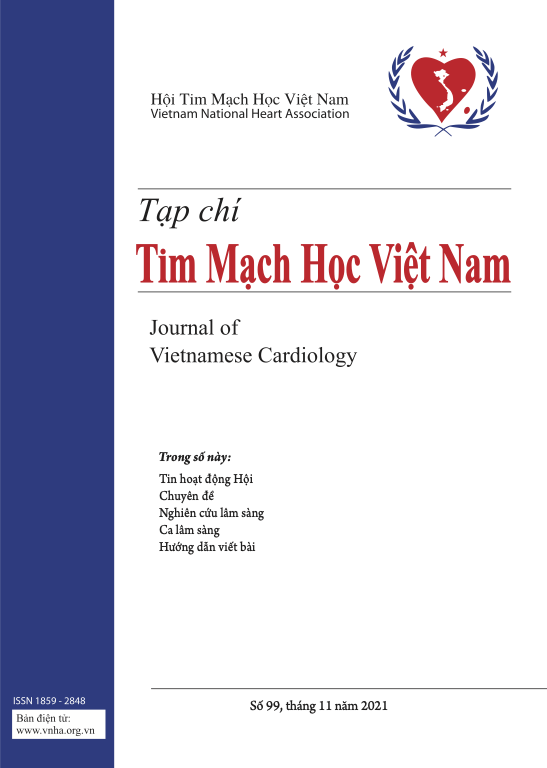Nghiên cứu mối liên quan của Huyết áp Phòng khám và Huyết áp lưu động 24 giờ với chỉ số cứng mạch ở bệnh nhân tăng huyết áp
DOI:
https://doi.org/10.58354/jvc.98.2021.103Tóm tắt
Đặt vấn đề: Các hướng dẫn về kiểm soát và điều trị tăng huyết áp (THA) hiện nay đều khuyến cáo mức huyết áp dựa trên chỉ số huyết áp đo được tại phòng khám (OBP). Có nhiều bằng chứng cho thấy rằng theo dõi huyết áp lưu động (ABPM) là một yếu tố dự báo tốt hơn về các sự kiện tim mạch lớn so với các phương pháp đo huyết áp tại các phòng khám. Đánh giá độ cứng mạch thông qua vận tốc sóng mạch gần đây đã được khuyến nghị trong các hướng dẫn về tăng huyết áp.
Mục tiêu: 1. Đánh giá chỉ số cứng mạch, trị số huyết áp đo phòng khám và huyết áp lưu động 24 giờ ở bệnh nhân tăng huyết áp. 2. Phân tích mối tương quan giữa chỉ số huyết áp đo tại phòng khám và huyết áp lưu động 24 giờ với vận tốc sóng mạch.
Đối tượng và phương pháp nghiên cứu: Gồm 99 bệnh nhân điều trị tại phòng khám ngoại trú khoa Nội Tim mạch 2, bệnh viện Nguyễn Trãi, TP. Hồ Chí Minh được chẩn đoán THA từ tháng 2/2019 đến tháng 2/2020. Phương pháp nghiên cứu mô tả cắt ngang.
Kết quả: Giá trị trung bình vận tốc sóng mạch (baPWV) trong nhóm NC là 1459,39 cm/s
Huyết áp phòng khám có giá trị thấp hơn huyết áp lưu động 24 giờ. Có sự khác biệt huyết áp đo được tại phòng khám và huyết áp lưu động 24 giờ, (50% chưa được kiểm soát tốt HA, 50% có hiện tượng vọt HA sáng sớm). Tuổi có mối tương quan mức độ khá chặt với vận tốc sóng mạch baPWV (r = 0 ,54, p < 0,05), OBP có tương quan mức độ vừa với vận tốc sóng mạch baPWV (r = 0,439, p < 0,01); ABPM có tương quan mức độ khá chặt với vận tốc sóng mạch baPWV (r>0,5, p<0,01). Vận tốc sóng mạch baPWV tăng theo phân độ THA. THA chưa kiểm soát và THA chưa kiểm soát ẩn giấu, THA buổi sáng có vận tốc sóng mạch cao hơn có ý nghĩa thống kê so với các nhóm HA bình thường và hiện tượng áo choàng trắng (p<0,01).
Từ khóa: Tăng huyết áp, huyết áp lưu động 24h, độ cứng mạch.
Tài liệu tham khảo
1. Huỳnh Văn Minh, Cao Trường Sinh (2015). Theo dõi huyết áp lưu động 24 giờ. Từ nguyên lý đến thực hành, NXB Đại học Huế.
![]()
2. Andreas Bur, et al. (2002). “Classification of blood pressure levels by ambulatory blood pressure in hypertension”, Hypertension,40, 6, 817-822.
![]()
3. Michael K Cummings, David P Ingham,Terry K Rosborough (2017). “Application and Effects of Ambulatory Blood Pressure Monitoring in Primary Care”, Journal of the Minneapolis Heart Institute Foundation,1, 2, 101-107.
![]()
4. Paul E Drawz, et al. (2017). “Effect of intensive versus standard clinic-based hypertension management on ambulatory blood pressure: results from the SPRINT (Systolic Blood Pressure Intervention Trial) ambulatory blood pressure study”, Hypertension, 69, 1, 42-50.
![]()
5. Bernhard M Kaess, et al. (2012). “Aortic stiffness, blood pressure progression, and incident hypertension”, Jama, 308, 9, 875-881.
![]()
6. Stephane Laurent, et al. (2006). “Expert consensus document on arterial stiffness: methodological issues and clinical applications”, European heart journal,27, 21, 2588-2605.
![]()
7. Julia Lortz, et al. (2019). “Rapid and automated risk stratification by determination of the aortic stiffness in healthy subjects and subjects with cardiovascular disease”, PloS one,14, 5, e0216538.
![]()
8. Sungha Park (2019). “Ideal target blood pressure in hypertension”, Korean circulation journal,49, 11, 1002-1009.
![]()
9. Margaret A Piper, et al. (2015). “Diagnostic and predictive accuracy of blood pressure screening methods with consideration of rescreening intervals: a systematic review for the US Preventive Services Task Force”, Annals of internal medicine,162, 3, 192-204.
![]()
10. British and Irish Hypertension Society (2004). “Validated BP Monitors for For Specialist Use”.
![]()
11. Suntech (2004). “Validation of the Oscar 2 oscillometric 24-h ambulatory blood pressure monitor according to the British Hypertension Society protocol 24-Hour Ambulatory Blood Pressure Monitoring System, Suntech oscar 2”.
![]()
12. J Rick Turner, Anthony J Viera,Daichi Shimbo (2015). “Ambulatory blood pressure monitoring in clinical practice: a review”, The American journal of medicine,128, 1, 14-20.
![]()
13. A Ungar, et al. (2004). “Isolated ambulatory hypertension is common in outpatients referred to a hypertension centre”, Journal of human hypertension,18, 12, 897-903.
![]()
14. Paul K Whelton, et al. (2018). “2017 ACC/AHA/AAPA/ABC/ACPM/AGS/APhA/ASH/ ASPC/NMA/PCNA guideline for the prevention, detection, evaluation, and management of high blood pressure in adults: a report of the American College of Cardiology/American Heart Association Task Force on Clinical Practice Guidelines”, Journal of the American College of Cardiology,71, 19, e127-e248.
![]()
15. Bryan Williams, et al. (2018). “2018 ESC/ESH Guidelines for the management of arterial hypertension: The Task Force for the management of arterial hypertension of the European Society of Cardiology and the European Society of HypertensionThe Task Force for the management of arterial hypertension of the European Society of Cardiology and the European Society of Hypertension”, Journal of hypertension,36, 10, 1953-2041.
![]()
Tải xuống
Đã Xuất bản
Các phiên bản
- 03-03-2023 (3)
- 01-03-2023 (2)
- 01-03-2023 (1)








